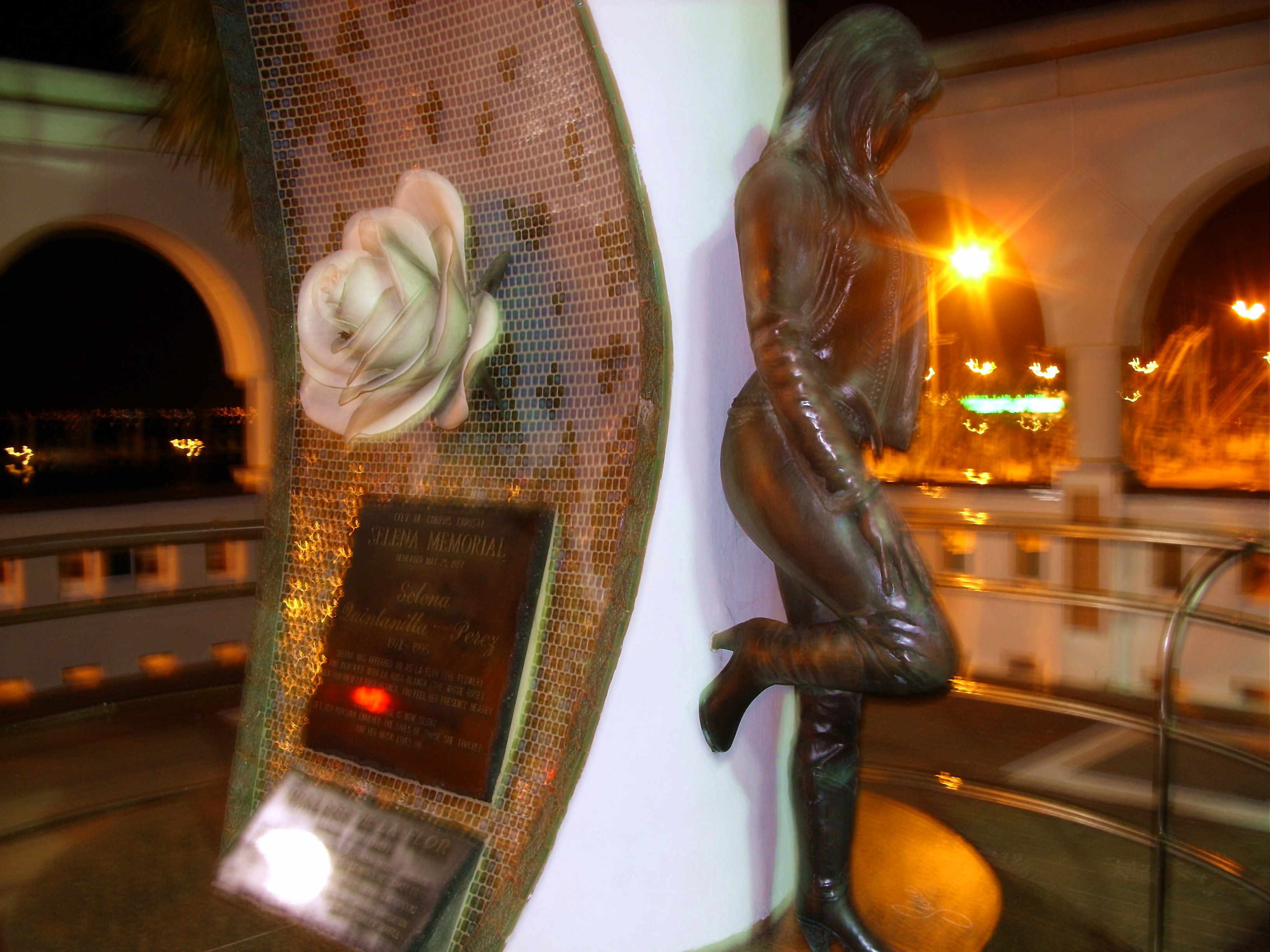| |
Selenidad
-
Selena, Latinos, and the Performance of Memory
written by Deborah Paredez
Duke University, August 2009

A review by a "Selena
fan"
-Bernard Greenberg
Deborah Paredez's magnificent
new book, Selenidad, is
not actually about
the late Selena Quintanilla Pérez
(1971-1995). This beautiful and intricately thought-out essay, by no means a
“fan book” nor a tribute to her, presents a highly academic and deeply
literate foray into deconstructionist sociology of Selena's “reception,” i.e.,
“reading” Selena's life, work, and tragic passing, as well as ongoing
reaction to them, as “texts”, whose ultimate “meaning” can only be
negotiated among their “readers,” including the author/critic and those
still reacting after fourteen years to the astounding rise, blazing full
blossom, and horrific death of the still-beloved star. As indicated by her
subtitle, Selena, Latinos, and
the Performance of Memory, Dr. Paredez concentrates on the reception of Selena's life, work, and death
within the US Latino/a community; she also devotes her last of five chapters
to what Selena and her flamboyant, extravagant femininity meant and mean to
various parties in the gay/lesbian community.
Dr. Paredez, Associate Professor of Theatre and Dance and
Associate Director of the Center for Mexican-American studies at the University of
Texas, Austin, and (as one can rapidly infer reading Selenidad)
very much a Selena fan and exact contemporary, is in a singularly
appropriate position to explore that area, having previously published works
in Latino/a and feminist studies. Given the breadth of Selena's visibility
and effect upon the Latino/a community, in the time of her life, death, and
memory even unto today, it is remarkable that no book exploring this area
has come forth until now; and, again, Dr. Paredez, with her specialties,
background, and affection and respect for Selena, seems the perfect person
to bring us one.
For Selena
Fans?
The
present reviewer, however, comes to Selenidad as
neither sociologist nor adept with the at-times clinical and cold loupe and
tweezers of the deconstructionist's toolbox, neither Latino nor expert in
Hispanic life and culture in the Estados
Unidos himself, but merely as
a knowledge-thirsty Selena devotee (is “fan” appropriate?) (although I will
note along this course, I have started
to become involved in Latinidad,
starting with Spanish), as all such, daily suffering the pain of the
lacerating contrast between what Selena gave us and what she then received.
Therefore, my posting of this review on SelenaForever.com is directed
primarily at other Selena devotees. Should y'all run out and buy Selenidad?
 Unquestionably,
without any hesitation, absolutely. While not a conventional “tribute book”
with fetching photos garlanded with excerpted song-texts (how many of
Selena's songs of lost love have so tragically and touchingly turned her
elegies: Mátame cielo, trágame
tierra, quiero morirme si no vuelve más!), the very
fact of Selenidad's
conception, execution, and publication is in and of itself a remarkable
tribute to the martyred cantante; that
her life, legacy, and ongoing veneration deserve and have now received a
study of this depth and brisk currency are testaments sure to her greatness,
significance, and uniqueness, and swell yet more the unceasing flood of
tears she now commands of us all. Selenidad is
about us, the living, not Selena, the beloved departed; it is about what we
(although focused on the Latino/a community) thought and think about Selena,
the brilliant star who passed so quickly over the Texas plains. Thus, not
biography, listing of Selena's major or minor accomplishments, discographies,
nor the like are to be found among Selenidad's
two hundred pages; for that, consult Joe Patoski's sadly out of print book,
or Gregory Nava's renowned movie, or other pages of this site. Unquestionably,
without any hesitation, absolutely. While not a conventional “tribute book”
with fetching photos garlanded with excerpted song-texts (how many of
Selena's songs of lost love have so tragically and touchingly turned her
elegies: Mátame cielo, trágame
tierra, quiero morirme si no vuelve más!), the very
fact of Selenidad's
conception, execution, and publication is in and of itself a remarkable
tribute to the martyred cantante; that
her life, legacy, and ongoing veneration deserve and have now received a
study of this depth and brisk currency are testaments sure to her greatness,
significance, and uniqueness, and swell yet more the unceasing flood of
tears she now commands of us all. Selenidad is
about us, the living, not Selena, the beloved departed; it is about what we
(although focused on the Latino/a community) thought and think about Selena,
the brilliant star who passed so quickly over the Texas plains. Thus, not
biography, listing of Selena's major or minor accomplishments, discographies,
nor the like are to be found among Selenidad's
two hundred pages; for that, consult Joe Patoski's sadly out of print book,
or Gregory Nava's renowned movie, or other pages of this site.
From a sheer fanship angle, putting aside for a short while
all that which is Dr. Paredez's explicit intent and purpose, the second
chapter of the book, analyzing the opening and closing numbers of the Last
Concert, viz., Disco
Medley and Como
La Flor, bespeak a depth and fineness of music/performance criticism
that only makes us pine for such analysis of the whole concert, nay,
Selena's entire oeuvre. Correctly identifying the video-recorded live
performances as the highest sacrament and talisman of Selena's “iconicity” (and
the Last Concert is the
ultimate “proof-text” among them), Dr. Paredez annotates these two numbers
with balletic analysis of Selena's every step and hand-gesture; we learn
that the beautiful hand-gesture with which Selena illustrates her (even more
now) signature
phrase Como la Flor (“Like
the Flower”) derives from a flamenco gesture
known as floreo (Latin,
“I flower”). Our attention is called to the dialectic between the bumpity cumbia backdrop
of this song and the stark lyric of rejection and hurt it foregrounds. We
are provided copious background on the Disco numbers, the meaning of Disco
repertoire in the Latino/a community, and relations between African-Americans
and Hispanics at that time and place, and how choice and setting of the Disco
Medley address them. Selena's
now-iconic “purple jump suit” (Paredez reads director Nava's opening scene
of JLópez-qua-Selena casually and randomly picking it out of a
crumplebox as an inside joke) is, as it were, taken apart thread by thread
as Paredez glosses its dialogue with the unique features of Selena's
physique, ditto the bell-bottoms crowned with flash reflectors meticulously
poised to spotlight virtuosic footwork, and so on --- if half of the
author's highly-enlightened speculations are true, we stand even more in awe
of Selena's brilliance, depth, professionalism, and commitment, and so the
stronger flow our tears. For this chapter alone fans should buy the book,
for it is (as Dr. Paredez confesses), the one about Selena per
se.
Selena
and the Latino/a Community
The rest of the book, upon which I am less competent to
comment, but still I find fascinating, very much seems to me to meet its
goal, as Dr. Paredez interviews and quotes Latino/as from all walks of
life, tells their stories of how Selena reminds them of theirselves, their
immigrant grandmothers, and so on – she tells us of the two theatre
productions circa 2000 about Selena's life, and the mainly Latino audience
who came (in insufficient numbers to sustain them) to see them. She speaks
to and about (now-grown) young girls who looked to Selena, before and after
her passing, for role-models of fully-achieved femininity, adulthood, and
accomplishment. She speaks of the gradual congealing of a group identity in
the highly diverse US Hispanic community, and how Selena, especially in her
passing, created a unifying event in which all these communities came
together and found each other. She calls to attention the wicked, ignorant,
and repugnant fulminations of Howard Stern (at the time of Selena's death),
for the explicit purpose of highlighting the solidity and unity of the
Hispanic community's response. Through a detailed history of the City of
Corpus Christi by way of Mexican Texas, Dr. Paredez recounts the history
of the Mirador de la Flor memorial
in Corpus Christi, highlighting Hispanic/Anglo conflict at the time, with
subtexts of “Anglo” value judgement upon the whole of the Hispanic community.
In the introductory matter and chapters, Dr. Paredez
compares Selena to other larger-than-life Latina icons who died tragically,
such as Eva Perón and Frida Kahlo, finding common elements in how Latino/as have come to “read” their “stories/texts.” She calls attention to earlier
Latino/a and Tejano performers (of all kinds) whose art and images
contributed indirectly to those we now identify with Selena, such as the
actresses Dolores del Rio, Lupe Velez, and Carmen Miranda. With an
encyclopaedic knowledge of Latino/a cultural history, especially of film,
dance, and song, Dr. Paredez leads us on a tour of Selena's artistic roots.
She did not arise in a vacuum.
 To
me this is all quite fascinating, and, as I have said, validates and
confirms my own faith in Selena's “specialness,” although Paredez seems to
counter that with the clear implication that Selena's success and subsequent
reaction to her passing were in fact flash points for underlying tensions
and problems, internal and external, within the Latino/a community. As an
“audience member” who cares deeply about this now-departed artist (as I do
about many artists departed centuries before), I care very much what other
people have to say about her and her work, and (at this time) extended
perorations on Selena (the person or the cultural “meme”) of the depth and
literacy of Selenidad remain
scarce. About “Latinity” (Latinidad, as
Paredez has it, not quite the same thing), let me remark that I have yet to
meet a native Spanish speaker (except some visitors from Spain) here in the
American Northeast who has not heard of Selena and responds to her name with
a gestures of respect and awe, and I have yet to meet an “Anglo” outside of
the fanship and a friend who hails from Texas who knew more about her than
her grim headline of a decade and half past. So, speaking as one who has
taken it upon himself to spread awareness of Selena's life, work, and legacy,
I am buoyed by the appearance of Dr. Paredez's book, here in the US, in
English, and hope that it heralds a new dawn of acknowledgement and
appreciation of a cosmically great artist and icon of the recent past, fit
to be revered, lionized, and taught to schoolchildren among the pantheon of
American heroes. To
me this is all quite fascinating, and, as I have said, validates and
confirms my own faith in Selena's “specialness,” although Paredez seems to
counter that with the clear implication that Selena's success and subsequent
reaction to her passing were in fact flash points for underlying tensions
and problems, internal and external, within the Latino/a community. As an
“audience member” who cares deeply about this now-departed artist (as I do
about many artists departed centuries before), I care very much what other
people have to say about her and her work, and (at this time) extended
perorations on Selena (the person or the cultural “meme”) of the depth and
literacy of Selenidad remain
scarce. About “Latinity” (Latinidad, as
Paredez has it, not quite the same thing), let me remark that I have yet to
meet a native Spanish speaker (except some visitors from Spain) here in the
American Northeast who has not heard of Selena and responds to her name with
a gestures of respect and awe, and I have yet to meet an “Anglo” outside of
the fanship and a friend who hails from Texas who knew more about her than
her grim headline of a decade and half past. So, speaking as one who has
taken it upon himself to spread awareness of Selena's life, work, and legacy,
I am buoyed by the appearance of Dr. Paredez's book, here in the US, in
English, and hope that it heralds a new dawn of acknowledgement and
appreciation of a cosmically great artist and icon of the recent past, fit
to be revered, lionized, and taught to schoolchildren among the pantheon of
American heroes.
Not just Latino/as, not just Texans or Mexican-Americans, not
just Americans, although they may each take something different from her
story, but the whole world should be proud that Selena lived here, and
singing and dancing spread her message of love. She was on the doorstep of
being adored by the whole world as she already was by the Latin-American
world.
Summary
Dr. Paredez's Selenidad should
be of interest to any literate (five-syllable lit
crit words abound) devotee,
fan, admirer of Selena and her work, and would seem inescapable for any
among those with a general interest in the history of Latin-Americans in the
United States. I would not recommend it at all (nor would, I hope, Dr. Paredez) as an introduction to Selena or her work or an attempt to use words
to explain why we all admire her so; Selena’s precious recorded/videotaped
performance legacy continues, as Dr. Paredez says, to be the best
introduction.
I look forward to future work from Dr. Paredez in this area,
and the reaction of knowledgeable critics and fans to this signal work.
-
August 22nd 2009
Click here for more information about Selenidad or to
get your copy.
|
|